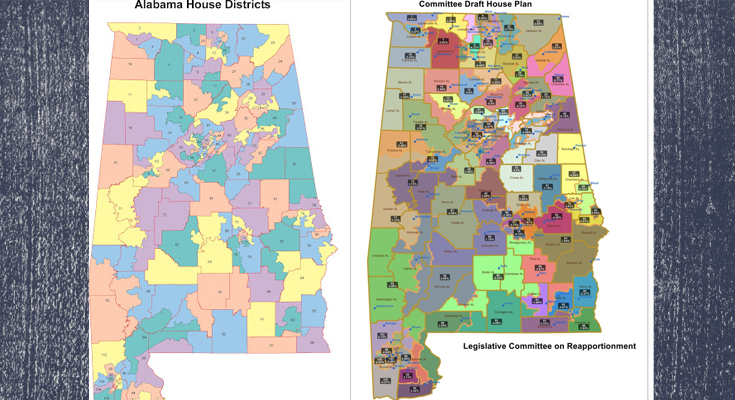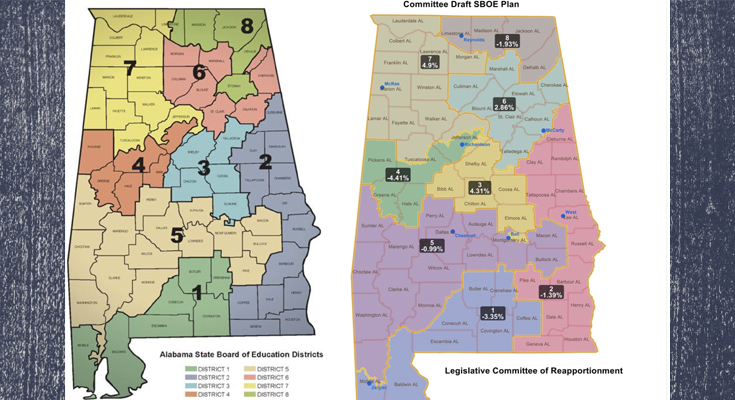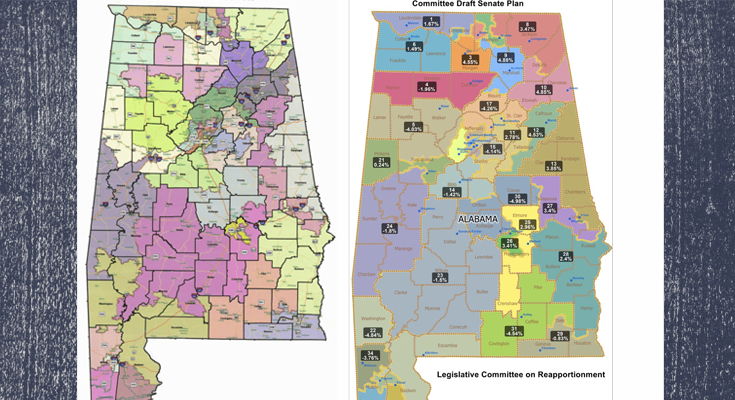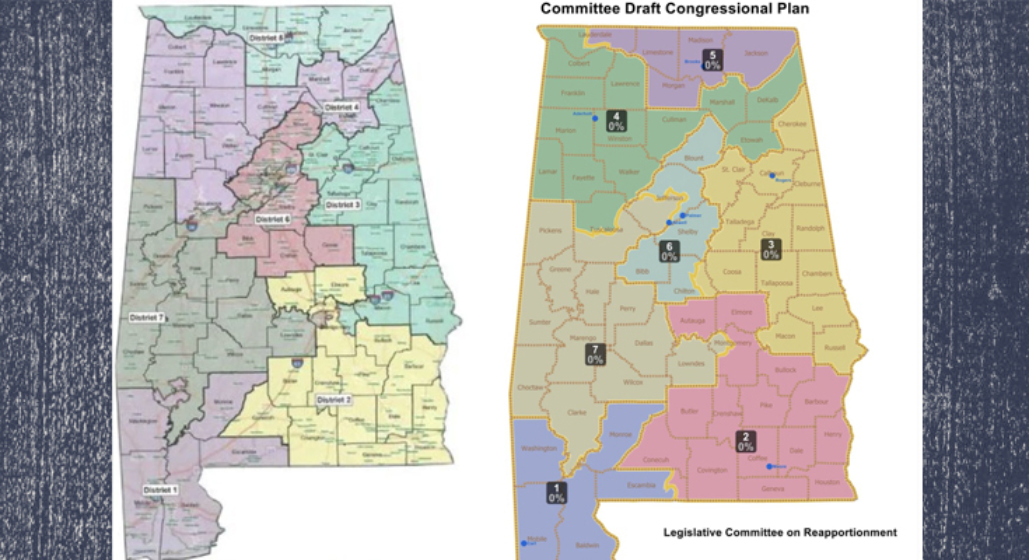By Brandon Mosley
Legislators are reviewing several draft maps showing redistricting proposals for Alabama, ahead of the special session Thursday.
The maps have been proposed to the Joint Committee on Redistricting. The proposed new Congressional districts look much like the districts do now, but there are many important changes.
Alabama avoided losing one of its seven Congressional Districts in the 2020 census. The state shocked many experts in the field, as well as government leaders, when final tabulations showed that the state, contrary to many predictions, had experienced enough growth to retain all of its Congressional Districts.
The Alabama Legislative Committee on Reapportionment will meet on Tuesday to consider the proposed reapportionment and redistricting. The committee, which is composed of members of both the Alabama House of Representatives and the Alabama Senate, is tasked with preparing new districts every 10 years based on the most recent census results.
This is not a definitive breakdown of the proposed new congressional districts and is based on early analysis by 1819 News. The Committee could reject these proposed maps on Tuesday and make additional changes.
The committee reapportioned each congressional district to represent 717,754 people. The Second Congressional District has one additional person. These numbers are based on the 2020 Census population reported on April 1 and do not account for births, deaths, or migration that has occurred since then.
The district which lost the most people was Alabama’s Seventh Congressional District, currently represented by Congresswoman Terri Sewell (D). Under the proposed plan, the Seventh District does not lose any area and picks up more of Jefferson County, all of Clarke County, and additional parts of the City of Montgomery.
Presently, the Seventh Congressional District includes Choctaw, Dallas, Greene, Hale, Lowndes, Marengo, Perry, Pickens, Sumter, and Wilcox Counties, along with portions of Clarke, Jefferson, Montgomery, and Tuscaloosa counties.
The Seventh Congressional District is Alabama’s only majority-minority district, and it will continue to be a majority-minority district, but the district did get much more diverse. Presently, the Seventh is 63.4% Black and 32.0% White. Seventy-one percent of the district voted for President Joe Biden. The proposed new Seventh District adds more suburban and rural Whites. According to the Committee, the proposal would make the Seventh the most racially diverse district in the state with an adult population that is 54.22% Black and 39.21% White. Blacks in Alabama in recent elections have voted over 90% for Democrats, while Whites have voted over 80% for Republicans. If turnout is equal, the Seventh District would remain solidly Democratic, but there is a potential for this being more competitive than it has been in recent elections.
The proposal for Alabama’s Sixth Congressional District also includes major changes. The Sixth District is currently represented by Congressman Gary Palmer (R). The new proposal moves a large portion of Jefferson County to the Seventh District. The Sixth District would also lose Coosa County and the eastern half of Chilton County to the Third Congressional District, leaving the Sixth with all of Shelby, Blount, and Bibb Counties, and parts of Jefferson and Chilton Counties. The population breakdown would be 71.97% White and 18.27% Black.
Alabama’s First Congressional District has seen massive growth in Baldwin County. The First District is currently represented by Congressman Jerry Carl (R). Because of the growth, the First would give up its current portion of Clarke County to the Seventh District, and part of Escambia County to the Second Congressional District. The proposed new First Congressional District would be 66.7% White and 24.77% Black and consist of Washington, Mobile, Baldwin, Monroe Counties, and the western portion of Escambia County.
Alabama’s Fifth Congressional District similarly saw substantial growth in Madison and Limestone Counties and in the proposed plan would give up the western half of Lauderdale County to the Fourth Congressional District. The Fifth District is currently represented by Congressman Mo Brooks (R), who is running for Senate in 2022. The proposed Fifth District will be 71.5% White and 17.06% Black and consist of Limestone, Madison, Morgan, and Jackson Counties, and part of Lauderdale County.
Alabama’s Third Congressional District is currently represented by Congressman Mike Rogers (R). In the proposed plan, the Third District would give up its current portion of Montgomery County, mostly to the Second District. It also picked up Coosa and the eastern portion of Chilton County from the current Sixth District, as well as a portion of Cherokee County from the Fourth. The proposed new Third District would include Calhoun, Chambers, Cherokee, Clay, Cleburne, Lee, Macon, Randolph, Russell, St. Clair, Talladega, Coosa, and Tallapoosa Counties and part of Chilton County. The adult population in the new proposal, based on the census, would be 68.41% White and 24.77% Black.
Alabama’s Second Congressional District is currently represented by Congressman Barry Moore (R). The Second District proposal would pick up part of Montgomery County from the current Third District and part of Escambia County from the current First. The proposed Second Congressional District would include most of Montgomery County, Autauga, Barbour, Bullock, Butler, Coffee, Conecuh, Covington, Crenshaw, Dale, Elmore, Geneva, Henry, Houston, and Pike Counties, as well as a portion of Escambia County. The Second District will become the second most racially diverse district in the state under the new proposal, 62.81% White and 29.18% Black.
Alabama’s Fourth Congressional District is currently represented by Congressman Robert Aderholt (R). Aderholt is the states' current longest-serving member of the U.S. House of Representatives. Under the proposal, the Fourth District would give up part of Tuscaloosa County to the Seventh, but gain much of Lauderdale County from the current Fifth District and a portion of Cherokee County from the current Third District. The proposed new Fourth District encompasses the counties of Cherokee, Etowah, Franklin, Colbert, Marion, Lamar, Fayette, Walker, Winston, Cullman, Lawrence, Marshall, and DeKalb Counties as well as part of Lauderdale County. The proposed Fourth Congressional District would be the least racially diverse district in the state at 83.44% White and 7.16% Black.
The last time an Alabama Congressional District flipped parties was in 2010 when Martha Roby (R) upset incumbent Democrat Bobby Bright in the Second Congressional District. Mo Brooks also won his office in that election, but the Democratic incumbent, Parker Griffith, had switched parties just prior to the election so Brooks defeated Griffith in the Republican Party primary rather than in the general election. The drafted districts would likely mean that Alabama would remain represented by six Republicans and one Democrat in the U.S. House of Representatives for the foreseeable future, barring a massive realignment of Alabamians’ political preferences.
The Committee is chaired by State Sen. Jim McClendon (R-Springville) and State Rep. Chris Pringle (R-Mobile). The Committee has held numerous public hearings on redistricting in the past weeks.
The Committee also has to reapportion and redistrict both the Alabama House of Representatives and the Alabama Senate as well as the state board of education. Those maps have also been released and can be viewed below.
The reapportionment and redistricting must be completed prior to the 2022 elections.


 PreviousNext
PreviousNext










